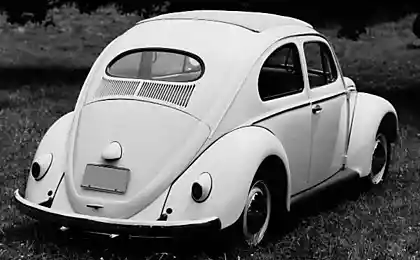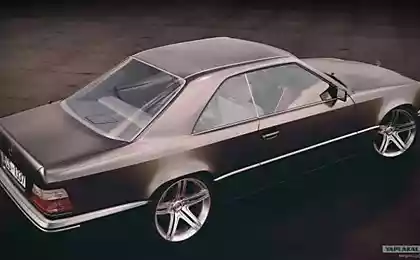1112
Volkswagen Beetle - the unknown pages of the biography
The history of the most popular cars in the world is told hundreds of times and it seems explored the length and breadth. Although it is how you look ... It really does not cause problems only postwar biography of "Bug": cars resumed production on the ruins of the factory in Wolfsburg, a crusade for improved quality, an amazing love that this unprepossessing-looking little car has won on all continents. It is another topic - the story of a remarkable machine that resembles a map of the world made up in the Middle Ages - entirely white spots. Let us dot the I, poring over the prewar events entertaining biography of the very first car Volkswagen.
26 photos + text
Photo 1.

Hungarian roots
History "Beetle" is considered by some historians, it makes sense to count as many as in 1925, when a young and talented Hungarian engineer Bela Baren scheme introduced affordable people's car. The project is a student of the Vienna Technical College seemed bold and promising. Taking the revolutionary hrebtovidnuyu support frame (this has just appeared on the Tatra 11) Baren ventured to place four-cylinder boxer engine is not in the front, in the Czech car and at the rear. Thus it was possible to do without the PTO shaft and bulky transmission tunnel, which has a positive impact on the size of the cabin. For perspective model Hungarian engineers offer all-metal body aerodynamic shape - even more bold decision at the time. Ten years later, these same principles will form the basis of the original Volkswagen, but in 1925 at the Baren had too many ideas and not enough money even to issue a patent application. As a result, a promising project remained on paper.
Photo 2. Bela Baren was unable to benefit from a promising student project of their own, but as a real talent still found its way. Subsequently Baren has become one of the leading developers and innovators in the field of passive safety. He has more than 2500 (!) Of patents, and in 1994 it was included in the "Automotive Hall of Fame»
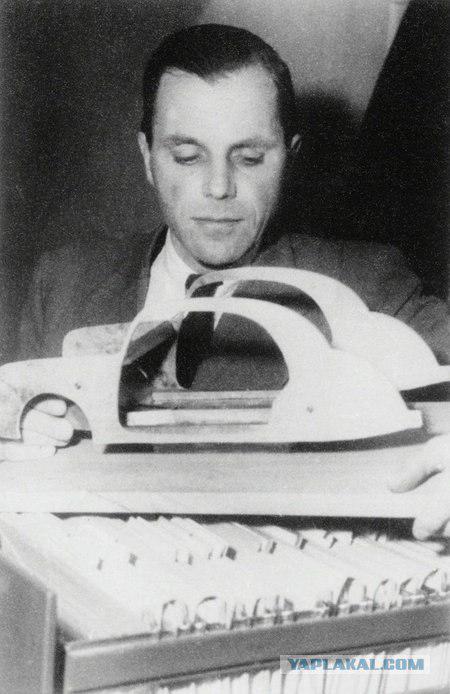
A few years later about it I recalled another Hungarian engineer and journalist Josef Ganz. Publisher car magazine Motor Kritik spared critical arrows against what was then the German automotive industry, accusing it of production is too expensive machines and disregard for the needs of the not very affluent citizens.
Photo 3. Josef Ganz driving Ardie Ganz, who in his own words became the inspiration for Dr. Porsche

This Ganz really wrong. By the early 30's own car had only one fiftieth German citizen - compared to the US, the ratio was 1 to 5. In this case, the market expensive and prestigious models of new items from the Maybach, Horch, Mercedes-Benz valued no less Rolls Royce, Packard and Bugatti. Another thing is that the mass of the car is as accessible and unpretentious as the same Ford T or Citroen A, he has never produced neither a German company.
Photo 4. Chassis Standard Superior with hrebtovidnoy frame and rear engine really resembles the original Volkswagen
Posted in [mergetime] 1305548604 [/ mergetime]
In fairness, Josef Ganz not only criticized, but also offered. Engineer publisher actively seek contact with the motorcycle company - German automotive firm represented him antagonists of technical progress - offering collaboration in the creation of machines "new type". So for the money the company Ardie in 1930 was created a prototype of an open Ardie Ganz, under the fragile contours of the body which hides all the same hrebtovidnaya frame, independent suspension and torsion bar at the rear of the engine.
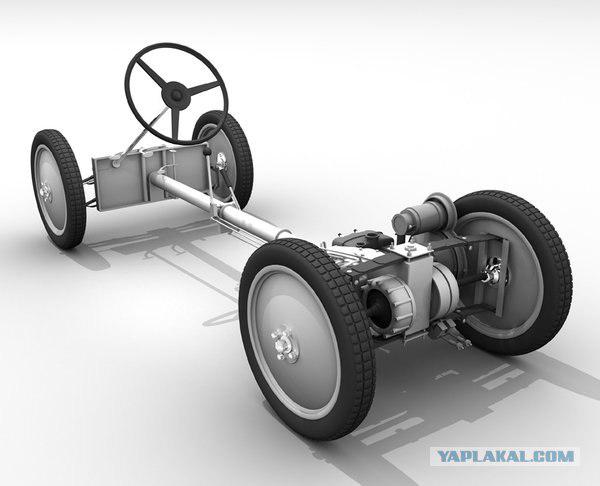
By a similar scheme - this time to fork firm Adler - built another prototype Maikafer, that is, "May Beetle". The name of the car has received not so much because of the resemblance to insects but because of what was presented in May. Of course, the two experimental models in every way touted in the pages of Motor Kritik.
Picture 5. Note - Standard Superior in the advertisement referred to as «deutschen volkswagen», which means "German people's car." So in this case it is not a trademark, and a simple definition
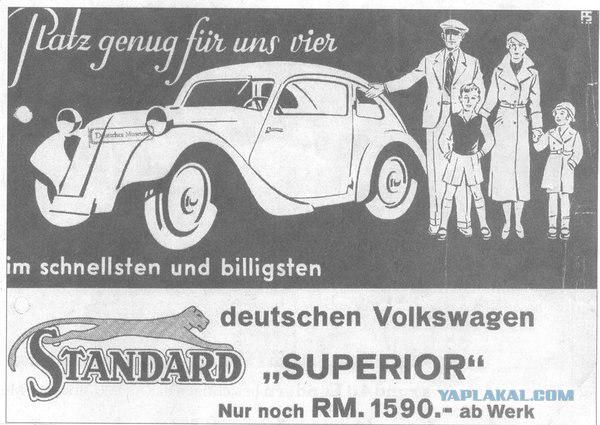
And the printed word has done its job. The concept of Josef Ganz seemed curious owner of another motorcycle company Wilhelm Gutbrod. As a result, at the Berlin Motor Show in February 1933, he debuted a small Standard Superior, built on the principles of "the May beetle", but with a neat closed body designed for two adults. At the rear of customer orders are placed or modest rack or child seat. But only one of the two. Kid two-cylinder two-stroke Superior equipped with 400 cc engine capacity of 12 liters. s., but the main thing was worth only slightly more expensive brands in 1500. At that time a very attractive price.
Photo 6. Zundapp type 12 - the first step of the Porsche design office to create Volkswagen
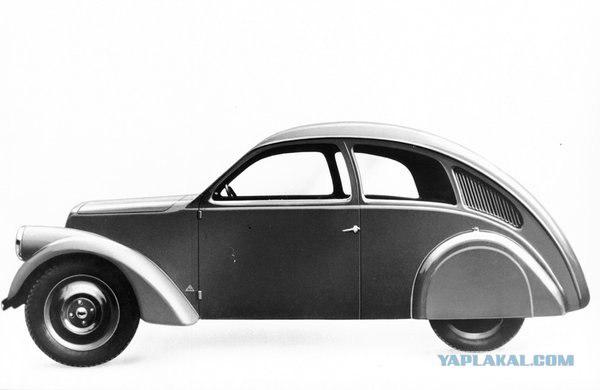
The machine, as it might seem, appeared in good time. The fact is that to power in the Weimar Republic just came Adolf Hitler. Fuhrer, though he never learned to drive, and how they say a little afraid to drive fast, nevertheless experienced undisguised passion for cars - garage demoniac leader of the Third Reich adorned with cars of different brands of the Alfa-Romeo and Horch to Tatra and Mercedes-Benz. He also belongs to the idea of mass construction of high-speed roads, which he said should be a "turning point in the history of transport in Germany." Remained mere trifle - to fill these expensive cars, and this task Hitler considered overarching.
Photo 7. Until today 32 NSU type, alas, live only in the form of a scale model. However, few bother specified date - 1934 year. In fact, the prototype appeared two years earlier

Examine Standard Superior at the Berlin Motor Show, the Führer, according to eyewitnesses, he was satisfied. It would seem that the head of state intervention could be a turning point in the fate of a small car. Modest capabilities of the company Standard is not enough to establish a mass production model, but with public support everything could change. But everything happened exactly the opposite. On the trouble Josef Ganz proved to be a Jew, and under the new regime had not had a chance to become the chief designer of the German car. Soon after fleeing from persecution by the Gestapo, a Hungarian engineer and left the country after many adventures settled in Australia, where about it for many years has not been heard.
Photo 8. "Beetle" is getting closer! Pilot V-2 with an open top - the first real prototype of the Volkswagen. Young man in a cap and driving - the son of Ferdinand Ferry Porsche
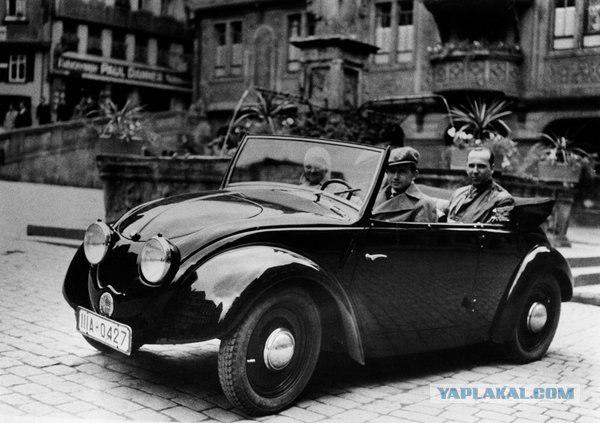
You ask, what is the connection between the machine and Ganz Volkswagen Beetle? Joseph himself had no doubt that the most direct. After the war, he would take to convince everyone that in 1931 Ferry Porsche - son Ferdinand - came to Frankfurt to personally experience the "May Beetle". Based solely on this fact, Ganz stated that the original design of Volkswagen rightfully belongs to him, not a Porsche. Thus Joseph had forgotten that his car suspiciously like structure Bela Baren, proposed back in 1925 ...
Photo 9. One of the thirty VW30, intended for large-scale testing. By the time the letter V - Versuch, I mean the "experimental" was replaced by the abbreviation of the German phrase "people's car» - VolksWagen. Note headlights took its rightful place on the wings, but the rear window is still missing
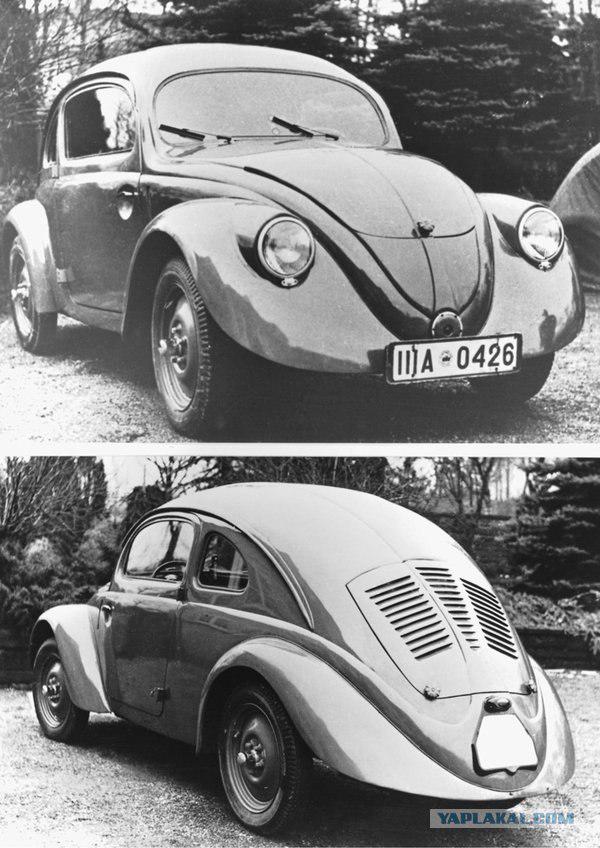
Picture 10. The prototype V-3 (the car can be identified by an increase over the V-1 and V-2 front luggage compartment lid) was collected in October 1936 - four months after the agreed contract period

In any case, in 1931, neither of which Volkswagen nor Porsche Ferdinand nor his son did not even think. While just created Dr. Ing. h. c. F. Porsche GmbH, or simply "Engineering Bureau Dr. Porsche" took any job offers. One of the first orders - the fifth, to be exact - was the project for the motorcycle company Zundapp, who decided to enter the market of cars. I must say that the machine, code-named type 12 is much more like the future Volkswagen, rather than the same Standard Superior. Learn and general outline of the body, and the proportions and the characteristic rear-engined layout, and four-room. But then three prototypes did not get. Firm of Nuerburg, after weighing all the pros and cons, decided to concentrate on the production of motorcycles and stopped funding the ambitious project.
Picture 11. Especially for the opening ceremony, created three "hybrid" option. From a technical point of view it VW30, but with a new design headlights, fully hinged trunk lid, doors coming off the direction of travel and a rear window
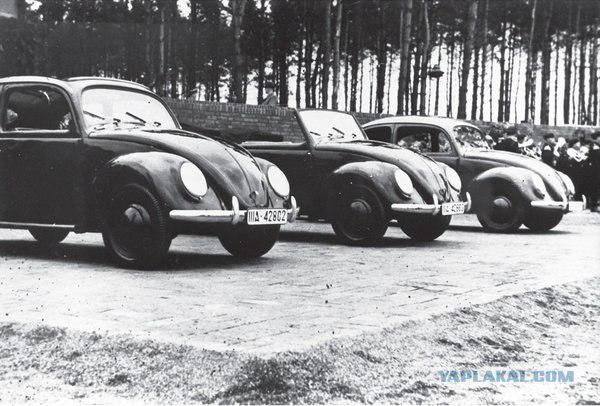
Soon after the creation of the "mass of a vehicle" interested firms NSU. New type 32 retained recognizable features of the body of the 12th model, while significantly increased in size, and in the engine compartment located behind the rear axle located boxer 4-cylinder air-cooled engine. Alas, but the project was not lucky to become a reality. In 1932, NSU sold its automotive department of FIAT and left the game.
Picture 12. The final version of the car has received index VW38. That this car journalist New York Times in his report to the Berlin Motor Show for the first time call "beetle»

However, the operating time for NSU and Zundapp convinced Porsche to the prospects of the chosen direction, and Ferdinand decided to take the initiative. First, he personally made the requirements for the future "people's car". He believes that the model should be unpretentious and practical. That's why Porsche found it necessary to use air-cooled engine, greatly simplifies operation. Antifreeze in those days had not been invented, and a heated garage in Germany was a big napryazhenka. Supervmestitelnosti car is also not required. Enough to lounge could accommodate two adults and three children - in the view of Nazi propaganda ideal of the number of German family, as well as their simple luggage. More importantly, the simplified design promised a very attractive price. Dr. Porsche calculated that in mass production the price tag even 1500 brands will be profitable for the producer.
Picture 13. Judging from this photo Porsche before the war relied on exports. The dashboard is completely symmetrical, so rearrange the wheel to the right will not be difficult (!!!!!!!!!!!!!!!)

In January 1934, a document entitled "Proposals for the mass of the car," Ferdinand went to Berlin to the country's top leadership. Having carefully studied the "Proposals" Hitler in May Porsche invited to Berlin and asked him to continue work on a prototype car people. To the list of requirements of the Fuehrer did not add anything except the price of the car, which, in his opinion, should not go beyond 1000 Reichsmarks. Incidentally, while many asked for a motorcycle! And that's not all. In the case of signing the contract, 10 months Porsche were to present two prototypes to study the experts RDA - newly created "auto industry association of the Third Reich." They also had to decide the fate of the project.
Picture 14. The total mileage of all test VW30 has exceeded one million kilometers
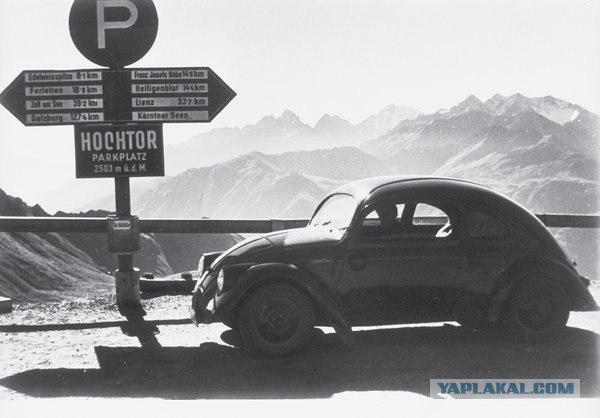
Berlin Dr. Porsche left mixed feelings. On the one hand he could take an interest in his project, on the other - and the RDA Hitler demanded the impossible. For an incredibly low price model and the extremely short time I added a very limited budget. For everything Porsche allocated 200 thousand marks. Yet the ambition of engineering genius prevailed - June 22, 1934, he put his signature on the contract.
Picture 15. Ferdinand Porsche next to the VW30. Curiously, only one car of this party was built in the workshop of the doctor, the other 29 are assembled in the factory Mercedes-Benz
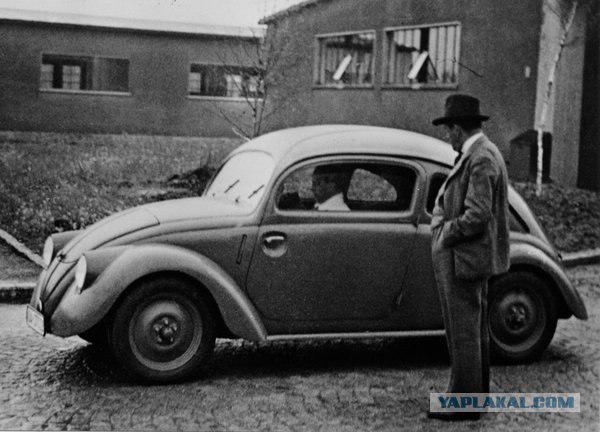
Of course, as expected Porsche, 10 months and 200 thousand marks was extremely inadequate. The total costs amounted to about 4 million, and the first of two prototypes was produced a year later. The two-door sedan V-1 (from the German Versuch - «Prototype number 1") made a trial trip on July 5, 1935, and his twin brother convertible that gets Index V-2, was released in the autumn. And of course, budget design left an imprint on the structure. The basis of the machine has already become familiar hrebtovidnaya frame, which is attached to the bottom of ... plywood. Body represented a wooden frame, paneled metal and plywood draped kozhzamom.
But if the same Zundapp type 12 only reminded all familiar image of the "Beetle", the V-1 is much closer to the final appearance of the model. Of course, in the prototype no thresholds, bumpers and rear glass doors swing open against the motion, front luggage compartment is opened only partially, and set close to each other lamps are mounted on the panel trunk rather than on the front wings.
Picture 16. Parked in the courtyard of the design bureau of Porsche cars include the latest versions. It's either VW38 and VW39

However, at least V-1 recalls and experimental Tatra V570, created in 1933. Subsequently, Hans Ledvinka, chief designer of the Czech company, as well as Josef Ganz will insist that the concept Volkswagen borrowed his car. Well, considering that after the war Tatra even win the corresponding trial (as a result of the Czech company VW will pay 3 million marks), it can be called these claims unfounded. However, we should not forget - in the early 30's, Hans Ledvinka Ferdinand Porsche and were good friends, if not best friends. And the recognition of the Porshe countrymen engineers (both born in Austria) have repeatedly exchanged ideas and did not conceal from each other secrets. Finally, Porsche accuse of plagiarism is not worth a purely mathematical reason. After work on the Zundapp type 12, forefather of the original Volkswagen, he started at the same time as the draft began Ledvinka Tatra V570.
Picture 17. Experimental Tatra V570 is similar to earlier instances of Volkswagen. However, work on their projects and Porsche Ledvinka began about the same time. So to accuse someone of plagiarism difficult
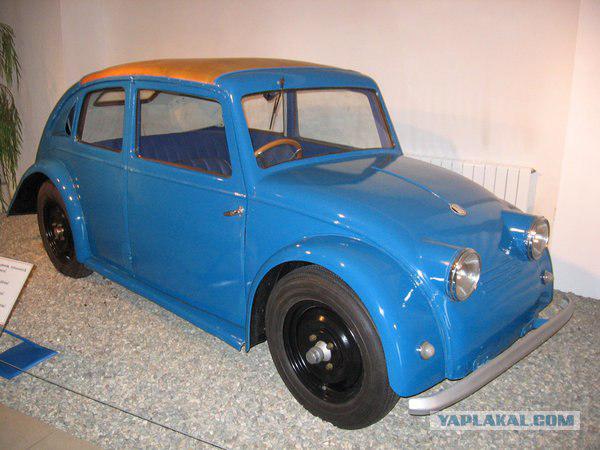
But we're getting ahead of myself. Experts RDA satisfied prototype V-1 and V-2, and Dr. Porsche has received a new order - by June 1936, was to develop a prototype for an improved three road tests. Externally, the car series of V-3 is not much different from the original V-1, but in technical terms, is a significant step forward. Plywood floor replaced the steel sheet and a registration under the bonnet was designed by engineer Franz Raymshpressom 23-horsepower four-cylinder boxer, known under the designation E60. Thanks to air-cooled centrifugal fan mounted on the shaft of the generator drivers can forget about what a motor to overheat.
Picture 18. The last instance Volkswagen Beetle, assembled at the plant in Mexico, July 30, 2003. As you can see similarities with the pre-war prototypes huge
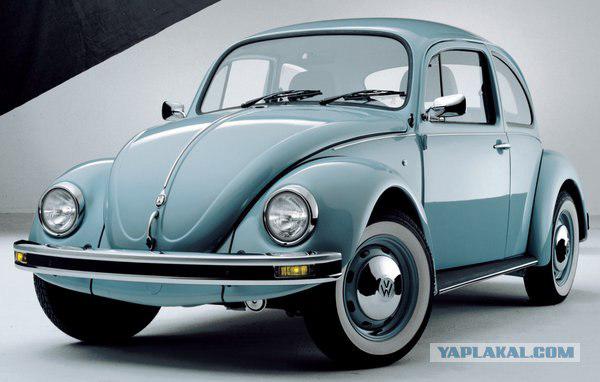
A curious feature of "treshki" was braking system with cable-operated. At the insistence of Hitler's new car has to be 100 percent German, while a patent for hydraulic brakes owned British firm Lockheed Mechanicals. Cable drive is deemed reliable, but outdated solution. When the driver presses the brake pedal, he thus moves forward steel lever inside the carrier pipe-ridge, which is attached to a rope leading to the four wheels. To stop the machine equipped with such brakes required a well-known physical force.
Picture 19. Fans of conspiracy theories claim that the experimental prototype of the American body studio Briggs, built in 1934, also has the right to be a relative of Volkswagen. After all, during his visit to the United States Ferdinand and Ferry Porsche studied this interesting concept.
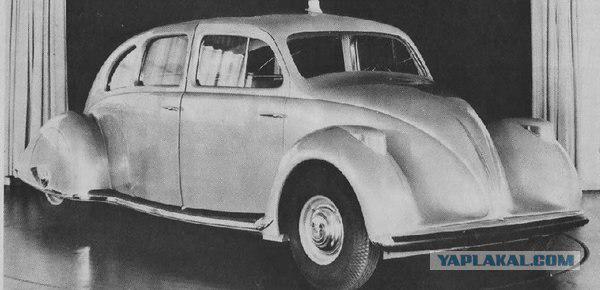
Work on the three machines series V-3 test was delayed and only managed to start 12 October 1936. Experimental models waited no laughing test of endurance length of 50 thousand. Km. Teams of two people for nearly three months relentlessly drove prototypes V-3, in the event of an unforeseen road repair laden parts, laid on a circular route in advance. On the day of each car passed by 750-800 km, and summed up the tests detailed technical report of 96 pages. Among the main drawbacks of the prototype was carried unreliable crankshaft, where cracks appeared weak connecting rods and brake drums and torsion bar suspension volatile corrosion.
Picture 20. Construction of the plant in the KDF-Stadt (now Wolfsburg) went really accelerated pace

By this time, without waiting for the findings of evaluation, Hitler personally ordered the construction of a further 30 copies of a prototype for a deeper study.
Source:
26 photos + text
Photo 1.

Hungarian roots
History "Beetle" is considered by some historians, it makes sense to count as many as in 1925, when a young and talented Hungarian engineer Bela Baren scheme introduced affordable people's car. The project is a student of the Vienna Technical College seemed bold and promising. Taking the revolutionary hrebtovidnuyu support frame (this has just appeared on the Tatra 11) Baren ventured to place four-cylinder boxer engine is not in the front, in the Czech car and at the rear. Thus it was possible to do without the PTO shaft and bulky transmission tunnel, which has a positive impact on the size of the cabin. For perspective model Hungarian engineers offer all-metal body aerodynamic shape - even more bold decision at the time. Ten years later, these same principles will form the basis of the original Volkswagen, but in 1925 at the Baren had too many ideas and not enough money even to issue a patent application. As a result, a promising project remained on paper.
Photo 2. Bela Baren was unable to benefit from a promising student project of their own, but as a real talent still found its way. Subsequently Baren has become one of the leading developers and innovators in the field of passive safety. He has more than 2500 (!) Of patents, and in 1994 it was included in the "Automotive Hall of Fame»

A few years later about it I recalled another Hungarian engineer and journalist Josef Ganz. Publisher car magazine Motor Kritik spared critical arrows against what was then the German automotive industry, accusing it of production is too expensive machines and disregard for the needs of the not very affluent citizens.
Photo 3. Josef Ganz driving Ardie Ganz, who in his own words became the inspiration for Dr. Porsche

This Ganz really wrong. By the early 30's own car had only one fiftieth German citizen - compared to the US, the ratio was 1 to 5. In this case, the market expensive and prestigious models of new items from the Maybach, Horch, Mercedes-Benz valued no less Rolls Royce, Packard and Bugatti. Another thing is that the mass of the car is as accessible and unpretentious as the same Ford T or Citroen A, he has never produced neither a German company.
Photo 4. Chassis Standard Superior with hrebtovidnoy frame and rear engine really resembles the original Volkswagen
Posted in [mergetime] 1305548604 [/ mergetime]
In fairness, Josef Ganz not only criticized, but also offered. Engineer publisher actively seek contact with the motorcycle company - German automotive firm represented him antagonists of technical progress - offering collaboration in the creation of machines "new type". So for the money the company Ardie in 1930 was created a prototype of an open Ardie Ganz, under the fragile contours of the body which hides all the same hrebtovidnaya frame, independent suspension and torsion bar at the rear of the engine.

By a similar scheme - this time to fork firm Adler - built another prototype Maikafer, that is, "May Beetle". The name of the car has received not so much because of the resemblance to insects but because of what was presented in May. Of course, the two experimental models in every way touted in the pages of Motor Kritik.
Picture 5. Note - Standard Superior in the advertisement referred to as «deutschen volkswagen», which means "German people's car." So in this case it is not a trademark, and a simple definition

And the printed word has done its job. The concept of Josef Ganz seemed curious owner of another motorcycle company Wilhelm Gutbrod. As a result, at the Berlin Motor Show in February 1933, he debuted a small Standard Superior, built on the principles of "the May beetle", but with a neat closed body designed for two adults. At the rear of customer orders are placed or modest rack or child seat. But only one of the two. Kid two-cylinder two-stroke Superior equipped with 400 cc engine capacity of 12 liters. s., but the main thing was worth only slightly more expensive brands in 1500. At that time a very attractive price.
Photo 6. Zundapp type 12 - the first step of the Porsche design office to create Volkswagen

The machine, as it might seem, appeared in good time. The fact is that to power in the Weimar Republic just came Adolf Hitler. Fuhrer, though he never learned to drive, and how they say a little afraid to drive fast, nevertheless experienced undisguised passion for cars - garage demoniac leader of the Third Reich adorned with cars of different brands of the Alfa-Romeo and Horch to Tatra and Mercedes-Benz. He also belongs to the idea of mass construction of high-speed roads, which he said should be a "turning point in the history of transport in Germany." Remained mere trifle - to fill these expensive cars, and this task Hitler considered overarching.
Photo 7. Until today 32 NSU type, alas, live only in the form of a scale model. However, few bother specified date - 1934 year. In fact, the prototype appeared two years earlier

Examine Standard Superior at the Berlin Motor Show, the Führer, according to eyewitnesses, he was satisfied. It would seem that the head of state intervention could be a turning point in the fate of a small car. Modest capabilities of the company Standard is not enough to establish a mass production model, but with public support everything could change. But everything happened exactly the opposite. On the trouble Josef Ganz proved to be a Jew, and under the new regime had not had a chance to become the chief designer of the German car. Soon after fleeing from persecution by the Gestapo, a Hungarian engineer and left the country after many adventures settled in Australia, where about it for many years has not been heard.
Photo 8. "Beetle" is getting closer! Pilot V-2 with an open top - the first real prototype of the Volkswagen. Young man in a cap and driving - the son of Ferdinand Ferry Porsche

You ask, what is the connection between the machine and Ganz Volkswagen Beetle? Joseph himself had no doubt that the most direct. After the war, he would take to convince everyone that in 1931 Ferry Porsche - son Ferdinand - came to Frankfurt to personally experience the "May Beetle". Based solely on this fact, Ganz stated that the original design of Volkswagen rightfully belongs to him, not a Porsche. Thus Joseph had forgotten that his car suspiciously like structure Bela Baren, proposed back in 1925 ...
Photo 9. One of the thirty VW30, intended for large-scale testing. By the time the letter V - Versuch, I mean the "experimental" was replaced by the abbreviation of the German phrase "people's car» - VolksWagen. Note headlights took its rightful place on the wings, but the rear window is still missing

Picture 10. The prototype V-3 (the car can be identified by an increase over the V-1 and V-2 front luggage compartment lid) was collected in October 1936 - four months after the agreed contract period

In any case, in 1931, neither of which Volkswagen nor Porsche Ferdinand nor his son did not even think. While just created Dr. Ing. h. c. F. Porsche GmbH, or simply "Engineering Bureau Dr. Porsche" took any job offers. One of the first orders - the fifth, to be exact - was the project for the motorcycle company Zundapp, who decided to enter the market of cars. I must say that the machine, code-named type 12 is much more like the future Volkswagen, rather than the same Standard Superior. Learn and general outline of the body, and the proportions and the characteristic rear-engined layout, and four-room. But then three prototypes did not get. Firm of Nuerburg, after weighing all the pros and cons, decided to concentrate on the production of motorcycles and stopped funding the ambitious project.
Picture 11. Especially for the opening ceremony, created three "hybrid" option. From a technical point of view it VW30, but with a new design headlights, fully hinged trunk lid, doors coming off the direction of travel and a rear window

Soon after the creation of the "mass of a vehicle" interested firms NSU. New type 32 retained recognizable features of the body of the 12th model, while significantly increased in size, and in the engine compartment located behind the rear axle located boxer 4-cylinder air-cooled engine. Alas, but the project was not lucky to become a reality. In 1932, NSU sold its automotive department of FIAT and left the game.
Picture 12. The final version of the car has received index VW38. That this car journalist New York Times in his report to the Berlin Motor Show for the first time call "beetle»

However, the operating time for NSU and Zundapp convinced Porsche to the prospects of the chosen direction, and Ferdinand decided to take the initiative. First, he personally made the requirements for the future "people's car". He believes that the model should be unpretentious and practical. That's why Porsche found it necessary to use air-cooled engine, greatly simplifies operation. Antifreeze in those days had not been invented, and a heated garage in Germany was a big napryazhenka. Supervmestitelnosti car is also not required. Enough to lounge could accommodate two adults and three children - in the view of Nazi propaganda ideal of the number of German family, as well as their simple luggage. More importantly, the simplified design promised a very attractive price. Dr. Porsche calculated that in mass production the price tag even 1500 brands will be profitable for the producer.
Picture 13. Judging from this photo Porsche before the war relied on exports. The dashboard is completely symmetrical, so rearrange the wheel to the right will not be difficult (!!!!!!!!!!!!!!!)

In January 1934, a document entitled "Proposals for the mass of the car," Ferdinand went to Berlin to the country's top leadership. Having carefully studied the "Proposals" Hitler in May Porsche invited to Berlin and asked him to continue work on a prototype car people. To the list of requirements of the Fuehrer did not add anything except the price of the car, which, in his opinion, should not go beyond 1000 Reichsmarks. Incidentally, while many asked for a motorcycle! And that's not all. In the case of signing the contract, 10 months Porsche were to present two prototypes to study the experts RDA - newly created "auto industry association of the Third Reich." They also had to decide the fate of the project.
Picture 14. The total mileage of all test VW30 has exceeded one million kilometers

Berlin Dr. Porsche left mixed feelings. On the one hand he could take an interest in his project, on the other - and the RDA Hitler demanded the impossible. For an incredibly low price model and the extremely short time I added a very limited budget. For everything Porsche allocated 200 thousand marks. Yet the ambition of engineering genius prevailed - June 22, 1934, he put his signature on the contract.
Picture 15. Ferdinand Porsche next to the VW30. Curiously, only one car of this party was built in the workshop of the doctor, the other 29 are assembled in the factory Mercedes-Benz

Of course, as expected Porsche, 10 months and 200 thousand marks was extremely inadequate. The total costs amounted to about 4 million, and the first of two prototypes was produced a year later. The two-door sedan V-1 (from the German Versuch - «Prototype number 1") made a trial trip on July 5, 1935, and his twin brother convertible that gets Index V-2, was released in the autumn. And of course, budget design left an imprint on the structure. The basis of the machine has already become familiar hrebtovidnaya frame, which is attached to the bottom of ... plywood. Body represented a wooden frame, paneled metal and plywood draped kozhzamom.
But if the same Zundapp type 12 only reminded all familiar image of the "Beetle", the V-1 is much closer to the final appearance of the model. Of course, in the prototype no thresholds, bumpers and rear glass doors swing open against the motion, front luggage compartment is opened only partially, and set close to each other lamps are mounted on the panel trunk rather than on the front wings.
Picture 16. Parked in the courtyard of the design bureau of Porsche cars include the latest versions. It's either VW38 and VW39

However, at least V-1 recalls and experimental Tatra V570, created in 1933. Subsequently, Hans Ledvinka, chief designer of the Czech company, as well as Josef Ganz will insist that the concept Volkswagen borrowed his car. Well, considering that after the war Tatra even win the corresponding trial (as a result of the Czech company VW will pay 3 million marks), it can be called these claims unfounded. However, we should not forget - in the early 30's, Hans Ledvinka Ferdinand Porsche and were good friends, if not best friends. And the recognition of the Porshe countrymen engineers (both born in Austria) have repeatedly exchanged ideas and did not conceal from each other secrets. Finally, Porsche accuse of plagiarism is not worth a purely mathematical reason. After work on the Zundapp type 12, forefather of the original Volkswagen, he started at the same time as the draft began Ledvinka Tatra V570.
Picture 17. Experimental Tatra V570 is similar to earlier instances of Volkswagen. However, work on their projects and Porsche Ledvinka began about the same time. So to accuse someone of plagiarism difficult

But we're getting ahead of myself. Experts RDA satisfied prototype V-1 and V-2, and Dr. Porsche has received a new order - by June 1936, was to develop a prototype for an improved three road tests. Externally, the car series of V-3 is not much different from the original V-1, but in technical terms, is a significant step forward. Plywood floor replaced the steel sheet and a registration under the bonnet was designed by engineer Franz Raymshpressom 23-horsepower four-cylinder boxer, known under the designation E60. Thanks to air-cooled centrifugal fan mounted on the shaft of the generator drivers can forget about what a motor to overheat.
Picture 18. The last instance Volkswagen Beetle, assembled at the plant in Mexico, July 30, 2003. As you can see similarities with the pre-war prototypes huge

A curious feature of "treshki" was braking system with cable-operated. At the insistence of Hitler's new car has to be 100 percent German, while a patent for hydraulic brakes owned British firm Lockheed Mechanicals. Cable drive is deemed reliable, but outdated solution. When the driver presses the brake pedal, he thus moves forward steel lever inside the carrier pipe-ridge, which is attached to a rope leading to the four wheels. To stop the machine equipped with such brakes required a well-known physical force.
Picture 19. Fans of conspiracy theories claim that the experimental prototype of the American body studio Briggs, built in 1934, also has the right to be a relative of Volkswagen. After all, during his visit to the United States Ferdinand and Ferry Porsche studied this interesting concept.

Work on the three machines series V-3 test was delayed and only managed to start 12 October 1936. Experimental models waited no laughing test of endurance length of 50 thousand. Km. Teams of two people for nearly three months relentlessly drove prototypes V-3, in the event of an unforeseen road repair laden parts, laid on a circular route in advance. On the day of each car passed by 750-800 km, and summed up the tests detailed technical report of 96 pages. Among the main drawbacks of the prototype was carried unreliable crankshaft, where cracks appeared weak connecting rods and brake drums and torsion bar suspension volatile corrosion.
Picture 20. Construction of the plant in the KDF-Stadt (now Wolfsburg) went really accelerated pace

By this time, without waiting for the findings of evaluation, Hitler personally ordered the construction of a further 30 copies of a prototype for a deeper study.
Source:
